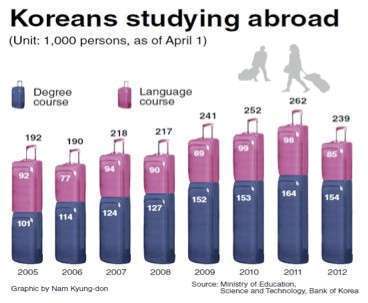June 19th, 2014

When I first traveled to South Korea in 2001 and visited with officials at the Ministry of Education and at a number of the universities, there were 45,685 South Korean students studying in the U.S. The numbers grew to 75,065 in 2008/09 but began to show a dip to 72,153 in 2009/10.
In this blog, we’ll provide an overview of the flow of students from South Korea and factors that may have an impact on the rise or decline of the numbers of students seeking higher education in the U.S.

1. Korea is the third largest source of international students to the U.S. after China and India.
2. More than 70,000 South Koreans studied on U.S. campuses in 2012–2013.
3. Korean parents place their children in U.S.-based private and public schools to have a better chance of being admitted to a U.S. college. (For example, at the University of Illinois, more than 69% of the Korean students admitted came directly from U.S. based high schools. Source: NAFSA International Education Magazine, April 2014)
4. According to the National Association of Independent Schools, Koreans are being quickly replaced by Chinese secondary students as the largest group of international students at independent schools. According to a report from the Association of Boarding Schools, Korean enrollments in member schools plunged 31 percent between 2010–2011 and 2012–2013 (from 3,800 to 2,600).
5. U.S. institutions continue to remain the favorite destination for study by South Korean students but the numbers are dropping as students are also looking at Canada as an alternative.
6. In 2012, 30.7 percent of Koreans studied in the United States, compared with 26.3 percent in China, 8.6 percent in Canada, 8.4 percent in Japan, and 7.2 percent in Australia, according to the Fulbright Commission in Seoul. Australia is aggressively marketing in South Korea to attract students to its institutions.
7. The rising cost of higher education in the U.S. and even Canada, Australia, Japan, is forcing South Korean students to look elsewhere, like Philippines and Malta, where education is affordable and English is the language of instruction. However, the number of students heading to these countries is very low. (According to Ministry of Education data from Fulbright Commission the share of South Koreans studying in the Philippines in 2010 and 2011 went from 1.1 to 1.2 percent, or to 3,238 students.)
8. The three factors that impact decisions made by South Koreans on studying abroad include: cost, value, and prestige. Most consider the cost of living in the UK as too high and consider U.S. universities as more prestigious than others
9. Prospective job applicants find that upon return to South Korea, employers prefer selecting a graduate from a U.S. institution.
10. In light of the weak job market for college graduates, a more popular option for Koreans is vocational schools that will be going through curriculum changes to include more hands-on training.
11. China is proving to be the Korean students’ second favored study abroad destination after the U.S. (According to the Wall Street Journal statistics: the number of Korean students flocking across the Yellow Sea to China grew more than three-fold between 2001 and 2012, from 16,000 to almost 63,000.)
12. More and more Korean companies are looking to hire college graduates who speak both fluent English and Chinese, since China is a key trading partner of South Korea.
13. On the other hand, many South Korean college graduates returning home are finding that the employers prefer hiring local college graduates as they see them to be less expensive and less inclined to change jobs.
14. Despite a weak economy and skyrocketing household debt, in 2012, Korean families spent $20 billion on private education (half of government education spending), or 2 percent of Korea’s GDP which makes education the nation’s largest spending area before defense expenditures.
15. The flow of Korean students to U.S. and abroad is contingent on whether Korean universities commit to reforms that will help their ranking on the list of top schools in the world. If they do not improve their ranking on the global level, South Korean students will continue to seek higher education opportunities in the U.S. and abroad.

Alan A. Saidi
Senior Vice President & COO, ACEI, Inc.
www.acei1.com


